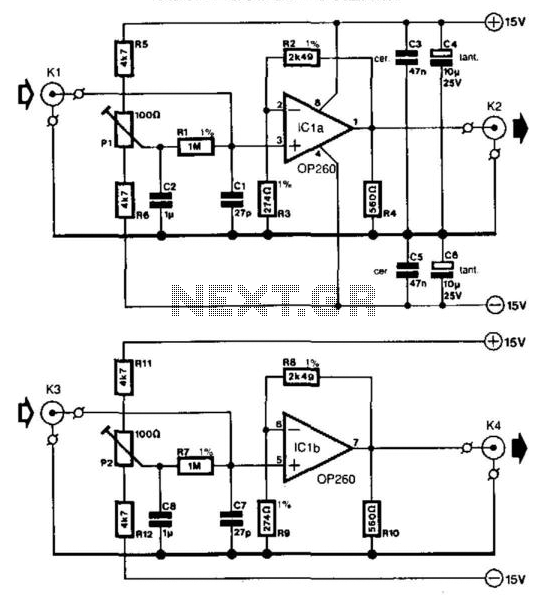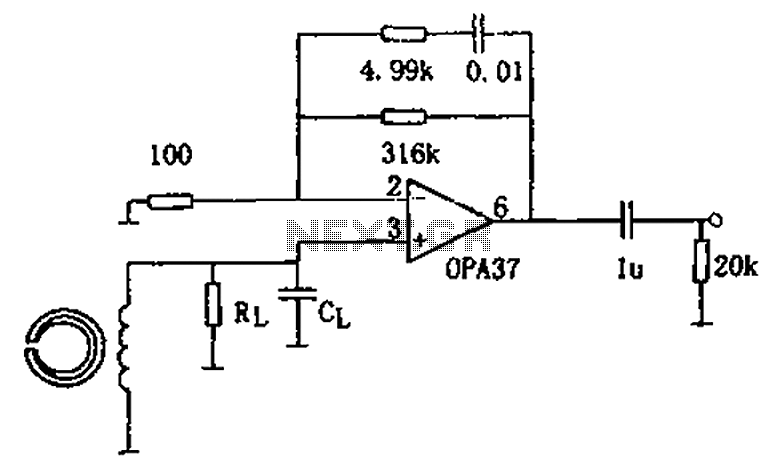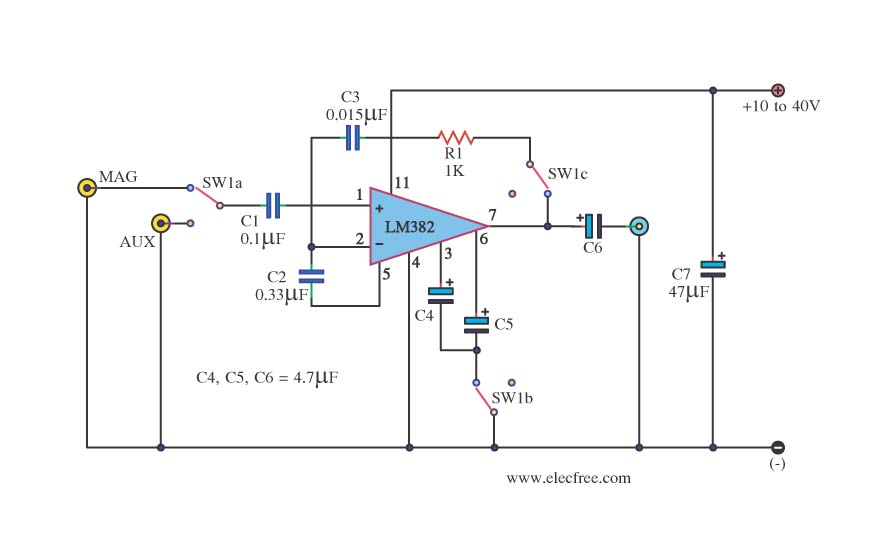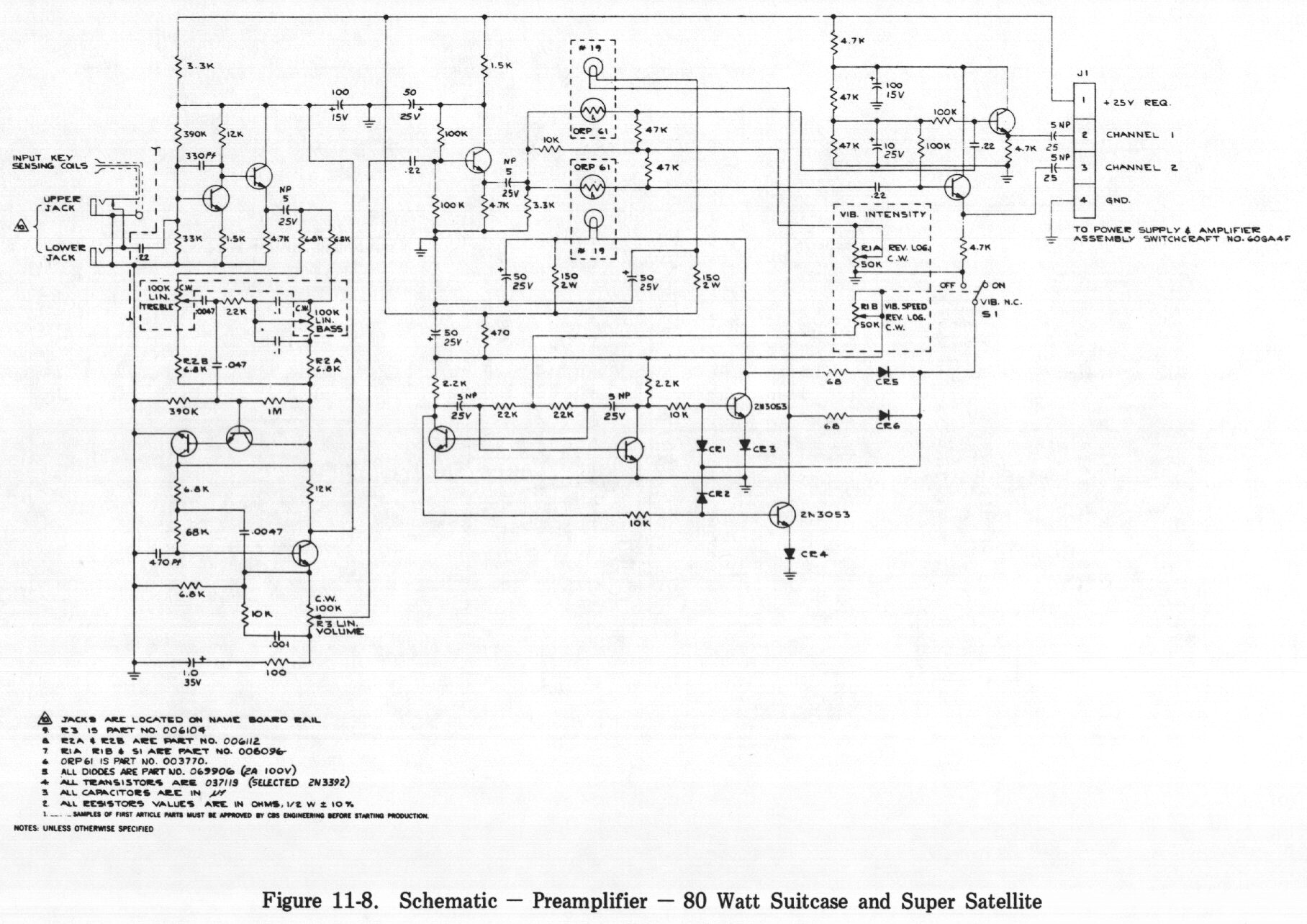
masthead preamp
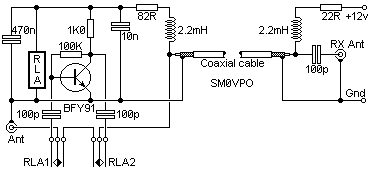
The first circuit is a simple preamplifier that illustrates the power arrangements for delivering DC to the amplifier via a coaxial cable. The second circuit includes a minor modification to allow the antenna to remain functional for transmitting. The preamplifier utilized in this circuit is a practical wideband amplifier, providing a gain of approximately 15 to 20 dB from 1.8 MHz to well over 200 MHz. Users may replace this circuit with their preferred amplifier suited for their specific frequency band. The 2.2 mH chokes should have a minimum reactance of 5000 ohms at the lowest frequency of operation. For 145 MHz applications, these chokes can be constructed using a few turns of wire. A 10-turn, 4 mm diameter coil in series with a 2.2 mH toroidal inductor has been effectively used. The relay should possess a coil resistance exceeding 1000 ohms and feature two-pole changeover contacts. In the construction of this circuit, two 5V PCB mounting relays with single-pole changeover contacts and 560-ohm coil resistance were utilized. When the DC power is turned off, the preamplifier becomes inactive, and the relay bypasses the amplifier, allowing for use with a low-power transmitter (typically up to 10 watts). The initial switch was integrated within the balun housing of a 2-meter beam antenna. It is crucial to ensure that DC 12 volts is never applied while transmitting, as this could damage the BFY91 transistor. Additionally, there is a brief delay between disconnecting the DC power and the preamplifier transitioning to a safe condition for transmitting.
The described circuit serves as an effective solution for enhancing signal strength in radio frequency applications. The preamplifier's wide bandwidth capability allows it to amplify signals across a significant range of frequencies, making it versatile for various communication needs. The incorporation of a relay enables the seamless transition between amplification and direct transmission, which is particularly useful for low-power transmitters.
The choice of the 2.2 mH chokes is critical, as their reactance must be sufficient to prevent signal loss at lower frequencies. The design allows for flexibility in construction, as users can customize the chokes based on their specific requirements. The use of a toroidal inductor minimizes electromagnetic interference, enhancing the overall performance of the circuit.
When designing the relay configuration, it is important to ensure that the coil resistance is adequate to prevent excessive current draw, which could lead to overheating or failure of the components. The two-pole changeover design offers the ability to switch between different circuit paths, optimizing the functionality of the preamplifier and transmitter.
Safety precautions are essential, particularly regarding the application of DC power during transmission. Implementing a delay mechanism ensures that the preamplifier does not inadvertently activate during transmission, protecting sensitive components from damage. This circuit exemplifies a practical approach to integrating amplification and transmission capabilities in radio frequency applications, suitable for hobbyists and professionals alike.The first circuit is a simple preamplifier showing the power arangements for conveying DC to the amplifier via the coaxial cable. The second circuit is a small modification so the antenna can still be used for transmitting. The actual preamplifier in this circuit is a practical wideband amplfier that gives about 15 - 20dB of gain from 1.
8 MHz thro ugh to well over 200 MHz. You will no-doubt replace this circuit for your own favorite amplifier for the band you are interested in. The 2. 2mH chokes should have an absolute minimum reactance of 5000 ohms at the lowest frequency to be used.
For 145 MHz these may simply consist of a few turns of wire. I personally used a 10-turn 4mm Dia. coil in series with a 2. 2mH torroidal inductor. The relay should have a coil resistance in excess of 1000 ohms and have tw1o-pole changeover contacts. When I built this circuit I used tw1o 5v PCB mounting relays, each having a single pole changeover contact.
The relays each had a 560 ohm coil. If the DC power is switched OFF the preamplifier will become inactive and the relay will pypass the amplifier. In this manner it may be used with a low-power transmitter (typically up to 10 watts). My first switch was built inside the balun housing of a 2-metre beam antenna. Note that the DC 12 volts should NEVER be applied whilst transmitting or the poor little BFY91 will be blown to bits.
There is also a short delay betw1een removing the DC and the preamp dropping out into a safe condition for transmitting 🔗 External reference
The described circuit serves as an effective solution for enhancing signal strength in radio frequency applications. The preamplifier's wide bandwidth capability allows it to amplify signals across a significant range of frequencies, making it versatile for various communication needs. The incorporation of a relay enables the seamless transition between amplification and direct transmission, which is particularly useful for low-power transmitters.
The choice of the 2.2 mH chokes is critical, as their reactance must be sufficient to prevent signal loss at lower frequencies. The design allows for flexibility in construction, as users can customize the chokes based on their specific requirements. The use of a toroidal inductor minimizes electromagnetic interference, enhancing the overall performance of the circuit.
When designing the relay configuration, it is important to ensure that the coil resistance is adequate to prevent excessive current draw, which could lead to overheating or failure of the components. The two-pole changeover design offers the ability to switch between different circuit paths, optimizing the functionality of the preamplifier and transmitter.
Safety precautions are essential, particularly regarding the application of DC power during transmission. Implementing a delay mechanism ensures that the preamplifier does not inadvertently activate during transmission, protecting sensitive components from damage. This circuit exemplifies a practical approach to integrating amplification and transmission capabilities in radio frequency applications, suitable for hobbyists and professionals alike.The first circuit is a simple preamplifier showing the power arangements for conveying DC to the amplifier via the coaxial cable. The second circuit is a small modification so the antenna can still be used for transmitting. The actual preamplifier in this circuit is a practical wideband amplfier that gives about 15 - 20dB of gain from 1.
8 MHz thro ugh to well over 200 MHz. You will no-doubt replace this circuit for your own favorite amplifier for the band you are interested in. The 2. 2mH chokes should have an absolute minimum reactance of 5000 ohms at the lowest frequency to be used.
For 145 MHz these may simply consist of a few turns of wire. I personally used a 10-turn 4mm Dia. coil in series with a 2. 2mH torroidal inductor. The relay should have a coil resistance in excess of 1000 ohms and have tw1o-pole changeover contacts. When I built this circuit I used tw1o 5v PCB mounting relays, each having a single pole changeover contact.
The relays each had a 560 ohm coil. If the DC power is switched OFF the preamplifier will become inactive and the relay will pypass the amplifier. In this manner it may be used with a low-power transmitter (typically up to 10 watts). My first switch was built inside the balun housing of a 2-metre beam antenna. Note that the DC 12 volts should NEVER be applied whilst transmitting or the poor little BFY91 will be blown to bits.
There is also a short delay betw1een removing the DC and the preamp dropping out into a safe condition for transmitting 🔗 External reference

